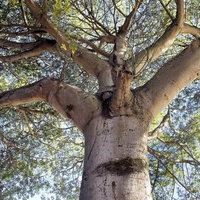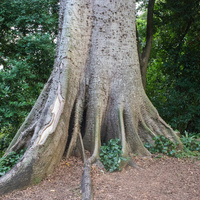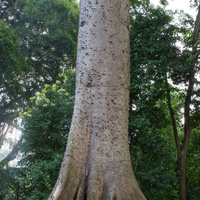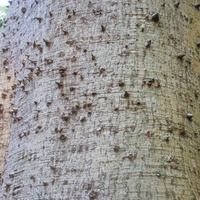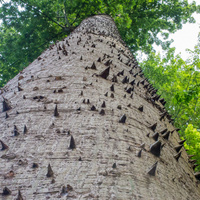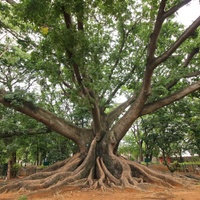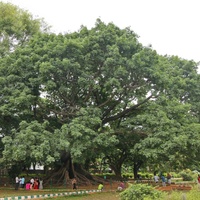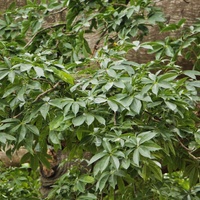Common name: Kapok
Other common names: Cotton Tree, Silk Cotton Tree
Description
Kapok is a large, imposing tree originating in tropical America, its natural range extending from Mexico, through Central America and the Caribbean, to northern parts of South America.
Exceptional specimens may reach heights of up to 40 m (130 ft), though it is more commonly a medium-sized tree 15 to 25 m (50 to 82 ft) tall.
There are two recognised subspecies, Ceiba pentandra var. indica and Ceiba pentandra var. caribaea. The latter easily distinguished by its large, prominent buttresses on mature trees, rising from the ground to 3 to 4 m (10 to 13 ft) in height up the trunk.
Depending on the growing conditions, the trunk may be clear of branches for most of the tree's height or is low-branching. On well-shaped trees, the trunk is tall, straight, round and bulbous, with prominent buttresses near the ground and an umbrella-shaped crown at the top, formed by far-stretching, horizontal branches. The bark is grey and smooth except for stout pyramidal spines on young trees, these becoming absent on mature trees.
The leaves are palmately compound, composed of five to seven dark green leaflets in a close arrangement, casting a deep shade. Leaf fall occurs in areas with a long or pronounced dry season, leaving the branches bare and exposed.
Flowering occurs in the dry season when the tree is near leafless, with blooms of large five-petaled, white or pink cup-shaped flowers. These are borne singly or in clusters of a few and in great numbers, though not every year. Opening just before sunset, they remain open throughout the night to be pollinated by bats, the tree's specialist pollinators.
Fertilised flowers develop into oval fruit 10 to 20 cm (4 to 8 in) long, green when young, with age becoming dark brown and with a weak shell that can be crushed by hand. When mature, the shell splits into five longitudinal sections, exposing a mass of woolly creamy-white hairs. Nestled amongst the hairs are up to a hundred small roundish black seed.
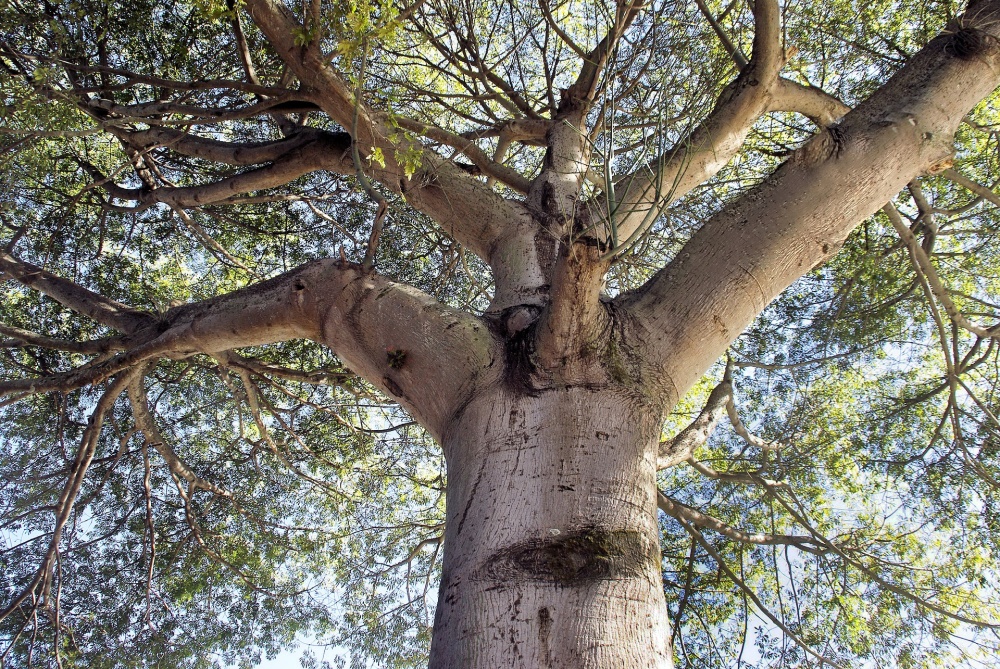
Image by DEZALB from Pixabay
Use
The hairs or fibres produced by the fruit are known as 'Kapok fibres, which long ago were commercially exploited until replaced by synthetic fibres derived from petroleum. Although not suitable for weaving into fabric because of their smoothness and weakness, their springiness, moth resistance, water-repellency and buoyancy make them useful for stuffing pillows, mattresses, sleeping bags and flotation devices, as well as for insulating against sound and temperature. Yields are estimated at 2.7 to 4 kgs (6 to 9 lbs) of fibre, per tree, per year.
The seed contains about 25% of a pale yellow to brown non-drying oil traded as 'Kapok oil', which is used in much the same way as refined cottonseed oil after refining. It has been used for various purposes, including as lamp oil by traditional people and, more recently, for making margarine and soap. Due to high nitrogen, phosphorus, and potassium concentrations, the leftover press cake can be fed to livestock but is largely indigestible and more suitable as organic manure or fertilizer.
The wood is lightweight, averaging around 330 kgs per cubic meter (20 lbs per cubic foot), and has low natural resistance to rot, decay and wood-boring insects. This limits its suitability for construction purposes other than as a substitute for Balsa (Ochroma pyramidale).
In coastal parts of the tree's native range, the trunk of tall, well-formed trees were once crafted into sea-worthy fishing canoes. These were known as 'dug-out canoes' because they were made by hollowing out the wood from the centre, after which the cavity was ribbed for reinforcement and the exterior shaped and painted. The craft of making dug-out canoes from Kapok trees has now mostly died out due to their replacement with prefabricated fibreglass canoes.
The flowers produce abundant nectar and are a valuable pollen source for brood-rearing honeybees, making it one of the most important trees for beekeepers in the tropics. The pure honey is pale amber with a characteristic sweet honey taste.
Health use
The bark, on wounding, yields a dark gum that swells in water and is similar to tragacanth-type gums except for its colour. Its properties and medicinal use are closest to Karaya Gum (from Sterculia urens). An astringent, it is used in traditional medicine in India as a treatment against bowel complaints.
General interest
According to the National Science Foundation of the United States (NSF), the flowers of a single tree can produce up to 190 litres (50 gallons) of nectar per season. This nectar attracts bats that travel up to 19 kilometres (12 miles) between trees, transferring pollen in the process.
Climate
Grows naturally in sub-humid to humid subtropical and tropical lowland to mid-elevation climates, generally areas with annual lows of 14 to 25°C, annual highs of 26 to 36°C, annual rainfall of 800 to 5000 mm, and a dry season of 7 months or less.
Growing
New plants are usually started from cuttings or seed. Seed are preferred because the trees develop stronger roots, though vegetatively propagated trees will begin to flower and fruit much earlier, when about five to six years old.
Performs best on free-draining clay, loam and sand soils of a moderately acid to slightly alkaline nature, generally with a pH of 4.7 to 7.5, and on sites with full sun exposure.
Problem features
Kapok is recorded as a weed of the natural environment in Australia and as a low-level weed in other places where it is introduced. However, there does not appear to be any record of it anywhere as a serious weed or invasive species. Its assessment by the Hawaii Pacific Weed Risk Assessment (HPWRA) project has not found it a high weed risk species for Hawaii.
Where it grows
References
Books
-
Adams, C. D. 1972, Flowering plants of Jamaica, University of the West Indies, Mona, Greater Kingston
-
Ashton, M.S. 1997, A field guide to the common trees and shrubs of Sri Lanka, Wildlife Heritage Trust of Sri Lanka, WHT Publications (Pvt.) Ltd., Colombo
-
Barwick, M., et al. 2004, Tropical & subtropical trees : a worldwide encyclopaedic guide, Thames and Hudson, London
-
Bradbear, N. 2009, Bees and their role in forest livelihoods : a guide to the services provided by bees and the sustainable harvesting, processing and marketing of their products, Food and Agriculture Organization of the United Nations (FAO), Rome
-
Brady, G. S. & Clauser, H. R & Vaccari, J. A. 2002, Materials handbook : an encyclopedia for managers, technical professionals, purchasing and production managers, technicians and supervisors, 15th ed., McGraw-Hill, New York
-
Crane, E., Walker, P. & Day, R. 1984, Directory of important world honey sources, International Bee Research Association, London
-
Croat, T. B. 1978, Flora of Barro Colorado Island, Stanford University Press, Stanford, California
-
Dastur, J. F. 1964, Useful plants of India and Pakistan : a popular handbook of trees and plants of industrial, economic, and commercial utility, 2nd ed., D. B. Taraporevala Sons, Bombay
-
Dewey, L. H. 1943, Fiber production in the western hemisphere, U. S. Department of Agriculture (USDA), Washington D.C.
-
Fawcett, W. 1891, Economic plants, An index to economic products of the vegetable kingdom in Jamaica, Jamaica Government Printing Establishment, Kingston
-
Food and Agriculture Organization of the United Nations (FAO) 1988, Traditional food plants : a resource book for promoting the exploitation and consumption of food plants in arid, semi-arid and sub-humid lands of eastern Africa, Food and Nutrition Paper No. 42, Rome
-
Francis, J. K. 1998, Tree species for planting in forest, rural, and urban areas of Puerto Rico, U.S. Department of Agriculture, Forest Service, International Institute of Tropical Forestry, Río Piedras, Puerto Rico
-
Francis, J. K. et al. 2000, Silvics of Native and Exotic Trees of Puerto Rico and the Caribbean Islands, Technical Report IITF-15, USDA Forest Service, Rio Piedras, Puerto Rico
-
Hill, A. F. 1952, Economic botany : a textbook of useful plants and plant products, 2nd ed, McGraw-Hill, New York
-
Howes, F. N. 1949, Vegetable gums and resins, Chronica Botanica Company, Waltham, Massachusetts
-
Jamieson, G. S. 1943, Vegetable fats and oils : their chemistry, production, and utilization for edible, medicinal and technical purposes, 2d ed, Reinhold, New York
-
Jensen, M. 1999, Trees commonly cultivated in Southeast Asia : an illustrated field guide, 2nd ed., Food and Agricultural Organisation of the United Nations (FAO) Regional Office for Asia and the Pacific (RAP), Bangkok
-
Krishen, P. 2006, Trees of Delhi : a field guide, Dorling Kindersley Publishers, Delhi
-
Lemmens, R.H.M.J., Louppe, D. & Oteng-Amoako, A.A. (eds). PROTA, Plant Resources of Tropical Africa, Volume 7(1) : Timbers 1, PROTA Foundation, Backhuys Publishers, Leiden
-
Little, E. L. et al. 1964 and 1974, Common trees of Puerto Rico and the Virgin Islands (2 volumes), Forest Service, U.S. Department of Agriculture (USDA), Washington D.C.
-
Lorenzi, H. 2002, Brazilian trees : a guide to the identification and cultivation of Brazilian native trees. Vol. 1, 4. ed, Instituto Plantarum de Estudos da Flora, Nova Odessa, Sao Paulo
-
Luna, R. K 1996, Plantation trees, International Book Distributors, Dehradun, Uttarakhand
-
McIlroy, R.J. 1963, An introduction to tropical cash crops, Ibadan University Press, Ibadan, Nigeria
-
Mollison, B. 1993, The permaculture book of ferment and human nutrition, Tagari Publications, Tyalgum, New South Wales
-
Nair, P. K. R. 1993, An introduction to agroforestry, International Centre for Research in Agroforestry (ICRAF), Kluwer Academic Publishers, Dordrecht
-
Porter, T. 2012, Wood : identification & use, Compact edition, Guild of Master Craftsman Publications, Lewes, East Sussex
-
Randall, R. P. 2002, A global compendium of weeds, R.G. and F.J. Richardson Press, Melbourne
-
Schubert, T. H. 1979, Trees for urban use in Puerto Rico and the Virgin Islands. U.S. Department of Agriculture, Forest Service, Southern Forest Experiment Station, New Orleans
-
Smith, P. P. 2018, The book of seeds : a life-size guide to six hundred species from around the world, The University of Chicago Press, Chicago
-
Standley, P. C. 1920, Trees and shrubs of Mexico, Government Printing Office (GPO), Washington D.C.
-
Stone, H. & Cox H. A. 1922, A guide to the identification of the more useful timbers of Nigeria, Crown Agents for the Colonies, London
-
Troup, R.S. & Joshi, H. B. 1975 to 1981, Silviculture of Indian Trees (3 volumes), Government of India Publications, New Delhi
-
Vázquez, Y. C. 1999, Potentially valuable Mexican trees for ecological restoration and reforestation, Institute of Ecology, Database SNIB-REMIB-CONABIO, Project J084, Mexico
-
West, A. P. & Brown, W. H. 1920, Philippine resins, gums, seed oils, and essential oils, Bureau of printing, Department of Agriculture and Natural Resources, Manila
-
Wood, I. M. 1997, Fibre crops : new opportunities for Australian agriculture, Queensland Department of Primary Industries (QLD DPI), Brisbane
Articles, Journals, Reports and Working Papers
-
Morton, J.F. 1964, Honeybee Plants of South Florida, Proceedings of the Florida State Horticultural Society, Vol 77:415-436.
